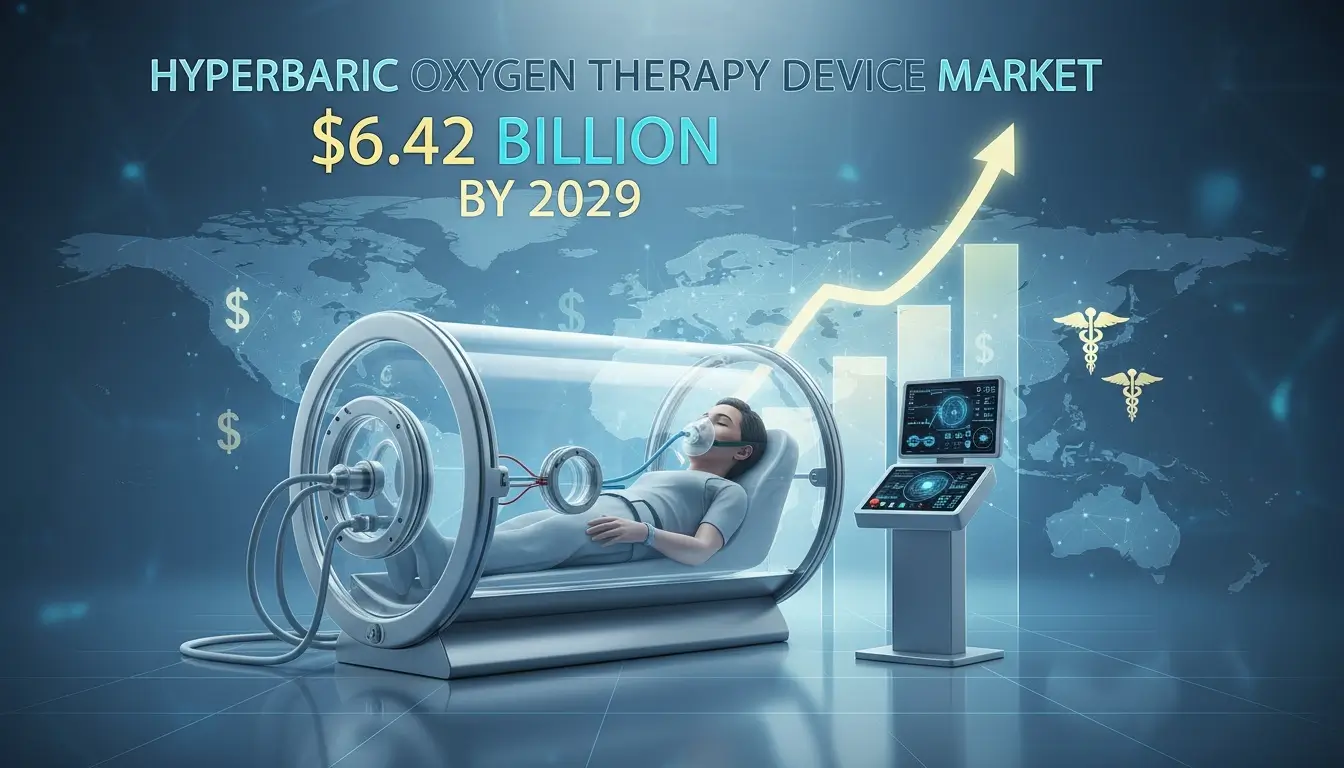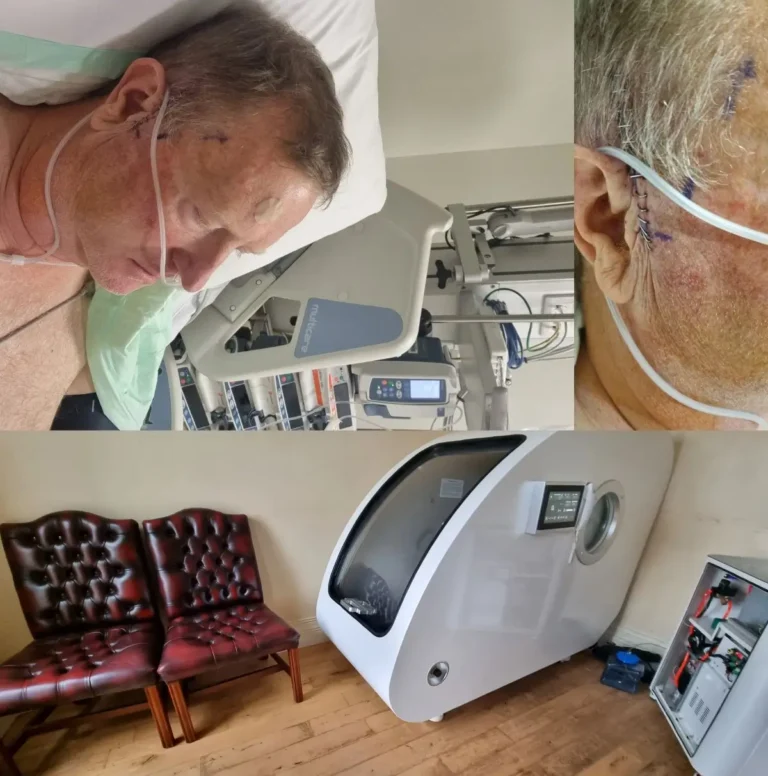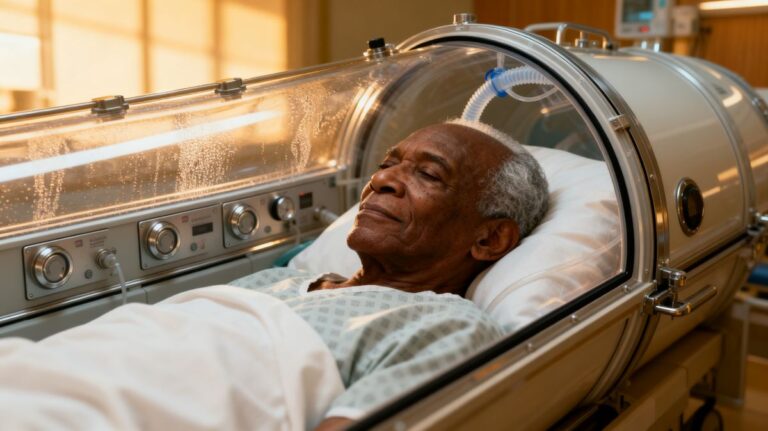- The global hyperbaric oxygen therapy device market will grow from $4.58 billion in 2025 to $6.42 billion by 2029.
- Diabetes prevalence is projected to increase from 529 million cases in 2023 to 1.3 billion by 2050, according to the Institute for Health Metrics and Evaluation.
- Automated logging software and artificial intelligence integration represent major technological advances in treatment precision.
- North America leads the current market, while Asia-Pacific shows the fastest growth trajectory through 2029.
- Monoplace, multiplace, and topical device categories serve applications ranging from wound healing to decompression sickness treatment.
The hyperbaric oxygen therapy (HBOT) device market is experiencing significant expansion, driven by increasing chronic disease rates and technological improvements in treatment delivery systems.
Market Growth Accelerates
The market reached $4.19 billion in 2024 and is projected to hit $4.58 billion in 2025, representing a compound annual growth rate of 9.2%, according to The Business Research Company. By 2029, the market value should reach $6.42 billion at an 8.8% CAGR.
The historic growth stems from several factors. Chronic wounds and diabetic ulcers have become more prevalent, creating demand for HBOT treatment options. Healthcare providers increasingly recognize HBOT’s effectiveness for decompression sickness and neurological disorders. Government funding programs have supported research and development activities, while healthcare infrastructure expansion has made these devices more accessible.
Diabetes Epidemic Fuels Demand
The rising number of diabetes cases stands out as a primary market driver. Data from the Institute for Health Metrics and Evaluation shows global diabetes cases will jump from 529 million in 2023 to 1.3 billion by 2050. The worldwide prevalence rate of 6.1% is set to climb substantially, with North Africa and the Middle East showing the highest rates at 9.3%, projected to reach 16.8% by 2050.
HBOT devices offer supplementary management for diabetes complications. The therapy aids wound healing and tissue repair through high-pressure oxygen application, potentially reducing diabetic foot ulcer complications and improving patient outcomes.
Technology Integration Transforms Treatment
Major manufacturers are incorporating advanced technology into hyperbaric chambers. Sechrist Industries Inc. launched the 3300 HM Hyperbaric Chamber and eHEAL System in January 2024. The 3300 HM features a Patient Step-in Entry design that eliminates the need for hyperbaric stretchers, while the eHEAL System provides automated treatment logging with real-time data recording capabilities.
The forecast period will see several technological trends emerge. Artificial intelligence and machine learning algorithms will enhance treatment protocols. Mobile applications and software platforms will improve patient monitoring. Wearable hyperbaric oxygen devices will offer new treatment options. Sports medicine facilities will adopt HBOT for athlete recovery programs.
Market Segmentation and Applications
The market divides into three main device types. Monoplace hyperbaric oxygen therapy devices accommodate single patients and include portable and fixed chamber options. Multiplace hyperbaric oxygen therapy devices range from two-person chambers to large systems holding 4-10 people, often featuring entertainment and monitoring systems.
Topical hyperbaric oxygen therapy devices target localized treatment for wounds, skin conditions, and minor injuries.
Applications span multiple medical areas. Wound healing remains the primary use case, followed by decompression sickness treatment, infection management, and gas embolism therapy. Hospitals represent the largest end-user segment, though home care adoption is growing.
Competitive Landscape
Leading companies operating in the market include Healogics LLC, SOS Medical Group Ltd., Environmental Tectonics Corporation, and BioBarica. These firms compete through product innovation, safety features, and treatment efficiency improvements.
Perry Baromedical Corporation, Shanghai Baobang Medical Equipment, and Hyperbaric Modular Systems Inc. focus on different market segments. European manufacturers like HAUX-LIFE-SUPPORT GmbH and BAROKS Hyperbaric serve regional markets, while companies such as Pan America Hyperbarics Inc. and AHA Hyperbarics target North American customers.
Regional Market Dynamics
North America dominated the market in 2024, benefiting from established healthcare infrastructure and insurance coverage for HBOT treatments. The region’s market strength comes from high diabetes prevalence, advanced medical facilities, and research funding.
Asia-Pacific will show the fastest growth through 2029. Factors include expanding healthcare systems, rising disposable incomes, and increasing awareness of HBOT benefits. Western Europe, Eastern Europe, South America, the Middle East, and Africa represent additional growth opportunities.
Future Market Drivers
Several factors will propel market expansion through 2029. The aging population requires more chronic disease management. Research funding continues to support new treatment indications and protocol refinements. Demand for portable chambers is rising. Healthcare spending and insurance coverage for HBOT are increasing globally.
The combination of regenerative medicine practices with HBOT represents an emerging trend. Clinical trials are exploring new applications, while technological advances make devices more accessible and effective. These developments position the hyperbaric oxygen therapy device market for sustained growth through the end of the decade.






